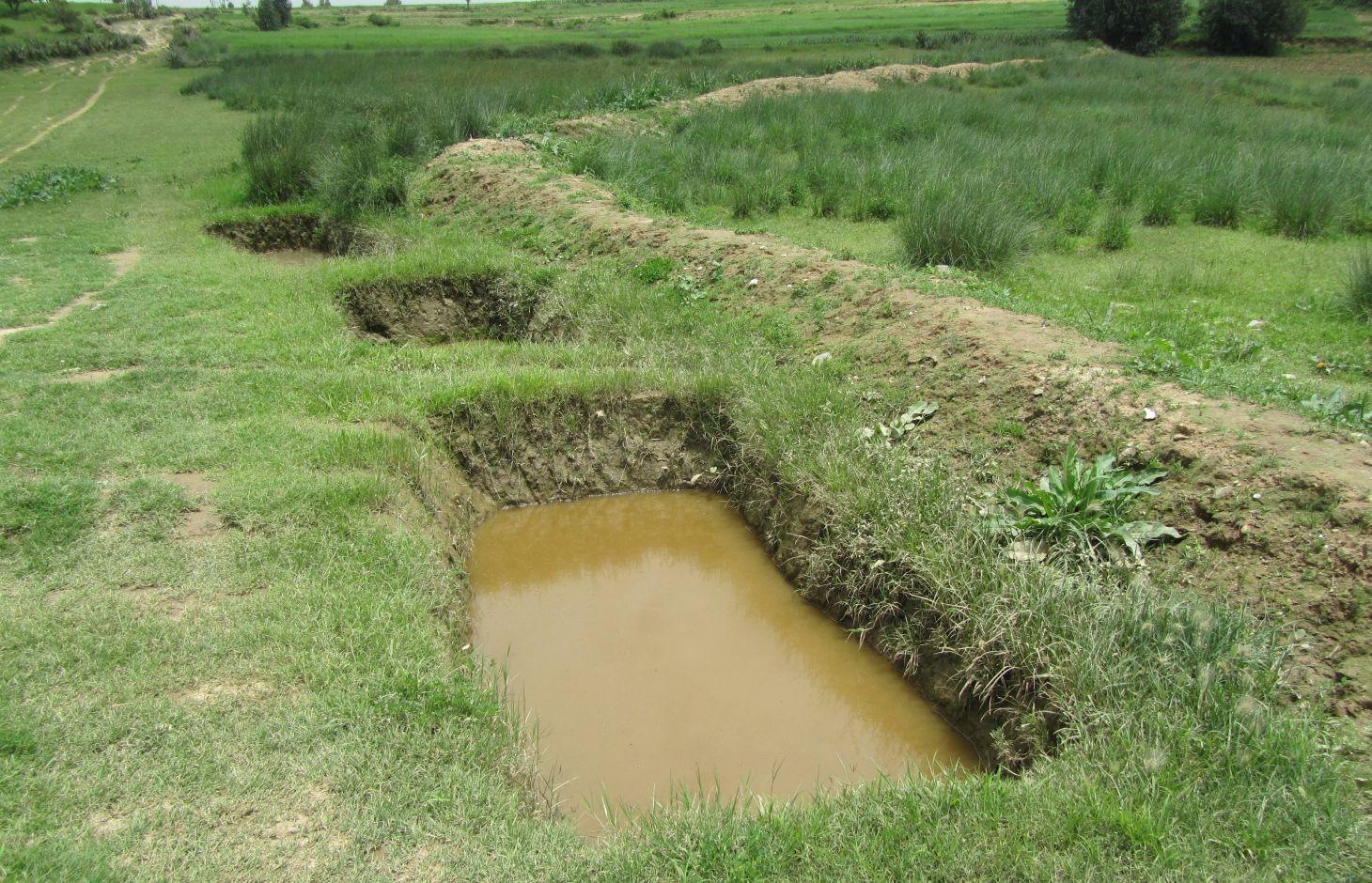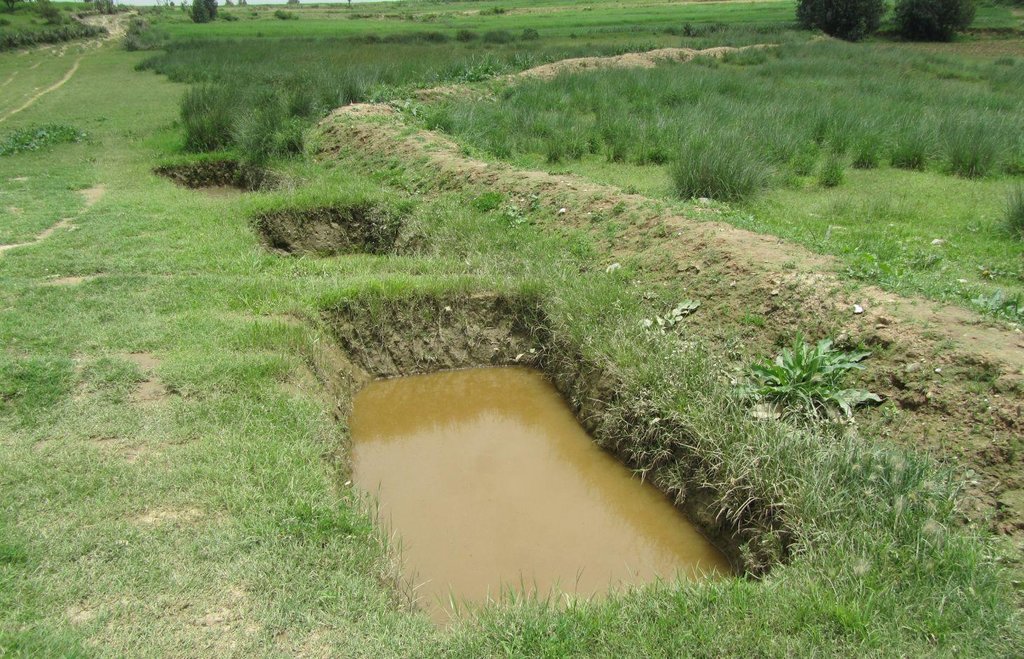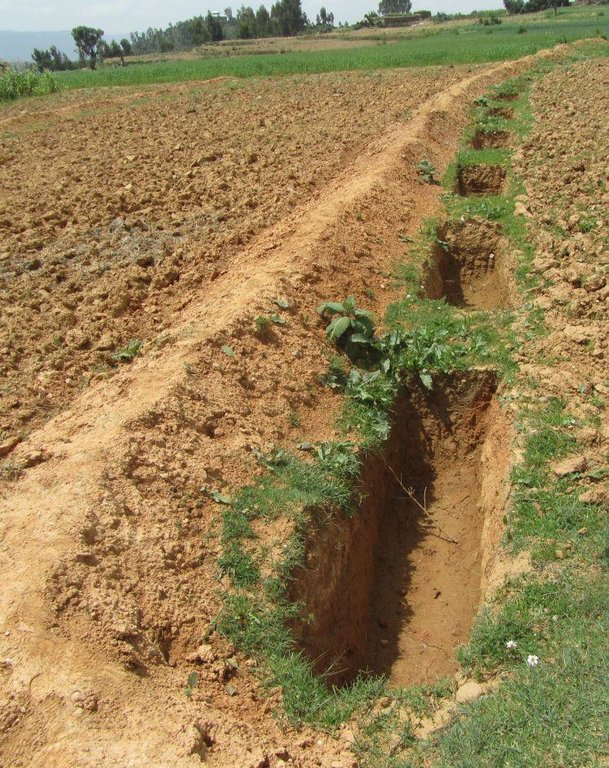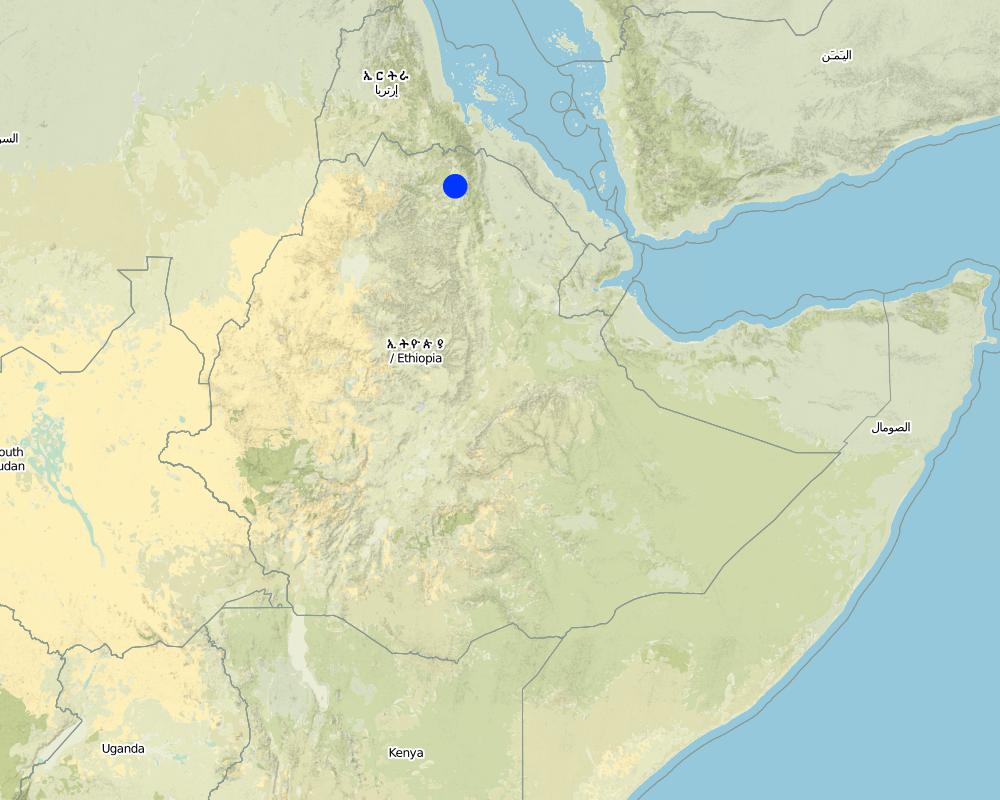Soil faced deep trench bunds [埃塞俄比亚]
- 创建:
- 更新:
- 编制者: Eyasu Yazew
- 编辑者: –
- 审查者: Fabian Ottiger, Alexandra Gavilano
Nay Hamed Amik Metrebwi Zala
technologies_1197 - 埃塞俄比亚
查看章节
全部展开 全部收起1. 一般信息
1.2 参与该技术评估和文件编制的资源人员和机构的联系方式
SLM专业人员:
Sibhatleab Mulugeta
Mekelle University
埃塞俄比亚
SLM专业人员:
Weldearegay Kifle
Mekelle University
埃塞俄比亚
有助于对技术进行记录/评估的机构名称(如相关)
Mekelle University (Mekelle University) - 埃塞俄比亚1.3 关于使用通过WOCAT记录的数据的条件
编制者和关键资源人员接受有关使用通过WOCAT记录数据的条件。:
是
2. SLM技术的说明
2.1 技术简介
技术定义:
Compacted soil bund constructed following a contour using a soil excavated from deep trenches on the up-slope side.
2.2 技术的详细说明
说明:
Soil faced deep trench bund is constructed by excavating trenches of 1 m deep, 0.5 - 1 m wide and 2 - 3.5 m long with spacing between trenches of 0.3 - 0.5 m along the contour and using the excavated soil to construct a compacted bund downslope. The smaller dimensions are usually used in cultivated lands while the larger are implemented in grazing lands.
Purpose of the Technology: Soil faced deep trench bund decreases slope length, runoff velocity and soil loss; and increases runoff harvesting, soil moisture and groundwater recharge.
Establishment / maintenance activities and inputs: Construction of soil faced deep trench bund involves alignment of a contour, excavation of trenches, construction and compaction of bund and planting grass, while the maintenance involves dredging of sediment from the trenches and use it for reinforcing the embankment.
Line level, tape meter, digging hoe, shovel and grass are needed for the establishment and maintenance.
Natural / human environment: The technology is implemented in moderate (5 - 8%) and hill (8 - 16%) slopes and in medium and heavy soil types of at least 1 m depth. It reduces runoff amount and velocity thereby decreasing soil loss and desertification/land degradation. It also improves soil moisture availability and groundwater recharge by encouraging lateral and vertical movement of water respectively.
It is mostly constructed using communal labour and there is an encouraging trend of spontaneous adoption. The technology is witnessed to be increasing crop and fodder production thereby improving the livelihood of the land users. It, however, is labour intensive and slightly reduces farm size.
2.3 技术照片
2.5 已应用该技术的、本评估所涵盖的国家/地区/地点
国家:
埃塞俄比亚
区域/州/省:
Tigray
有关地点的进一步说明:
Kilte Awlaelo
具体说明该技术的分布:
- 均匀地分布在一个区域
如果不知道精确的区域,请注明大致覆盖的区域:
- 10-100 平方千米
Map
×2.7 技术介绍
详细说明该技术是如何引入的:
- 通过项目/外部干预
3. SLM技术的分类
3.1 该技术的主要目的
- 减少、预防、恢复土地退化
3.2 应用该技术的当前土地利用类型

农田
- 一年一作
- 多年一作(非木材)
年作 - 具体指明作物:
- 谷类 - 大麦
- 谷物类 - 玉米
- 谷类 - 高粱
- 油料作物 - 向日葵、菜籽、其他
- wheat, teff
- elephant grass
每年的生长季节数:
- 1
具体说明:
Longest growing period in days: 150 Longest growing period from month to month: June - November

牧场
集约放牧/饲料生产:
- 收割和携带/零放牧
- 改良牧场
注释:
Major land use problems (compiler’s opinion): Soil erosion, overgrazing, decline of soil fertility and productivity.
Major land use problems (land users’ perception): Soil erosion, reduced soil depth, fertility and productivity.
3.4 供水
该技术所应用土地的供水:
- 雨养
3.5 该技术所属的SLM组
- 横坡措施
- 地下水管理
3.6 包含该技术的可持续土地管理措施

植物措施
- V2:草和多年生草本植物

结构措施
- S2:堤、岸
注释:
Main measures: structural measures
Secondary measures: vegetative measures
Type of vegetative measures: aligned: -contour
3.7 该技术强调的主要土地退化类型

土壤水蚀
- Wt:表土流失/地表侵蚀
- Wg:冲沟侵蚀/沟蚀

生物性退化
- Bc:植被覆盖的减少
注释:
Main type of degradation addressed: Wt: loss of topsoil / surface erosion
Secondary types of degradation addressed: Wg: gully erosion / gullying, Bc: reduction of vegetation cover
Main causes of degradation: soil management, overgrazing, Heavy / extreme rainfall (intensity/amounts), population pressure
Secondary causes of degradation: crop management (annual, perennial, tree/shrub) (Crop residues are removed during harvesting), over-exploitation of vegetation for domestic use, change of seasonal rainfall, droughts, land tenure, poverty / wealth, education, access to knowledge and support services
3.8 防止、减少或恢复土地退化
具体数量名该技术与土地退化有关的目标:
- 减少土地退化
- 修复/恢复严重退化的土地
注释:
Main goals: mitigation / reduction of land degradation
Secondary goals: rehabilitation / reclamation of denuded land
4. 技术规范、实施活动、投入和成本
4.1 该技术的技术图纸
技术规范(与技术图纸相关):
Soil faced deep trench bunds are structures constructed by excavating trenches following the contour and using the excavated soil to establish compacted bund on the lower side.
Location: Tigray. Kilte Awlaelo
Date: 10/10/2014
Technical knowledge required for field staff / advisors: moderate
Technical knowledge required for land users: low
Main technical functions: control of dispersed runoff: retain / trap, reduction of slope length
Secondary technical functions: increase of infiltration, increase / maintain water stored in soil, increase of groundwater level / recharge of groundwater, sediment retention / trapping, sediment harvesting
Aligned: -contour
Vegetative material: G : grass
Number of plants per (ha): 1600
Vertical interval between rows / strips / blocks (m): 1 - 1.2
Spacing between rows / strips / blocks (m): 10 - 15
Vertical interval within rows / strips / blocks (m): 0.5
Grass species: Elephant grass is mostly planted on the bunds in a single row at spacing of 0.5 m.
Slope (which determines the spacing indicated above): 6.5 and 12%
Gradient along the rows / strips: 0%
Bund/ bank: level
Vertical interval between structures (m): 1 - 1.2
Spacing between structures (m): 10 - 15
Depth of ditches/pits/dams (m): 1
Width of ditches/pits/dams (m): 0.5 - 1
Length of ditches/pits/dams (m): 2 - 3.5
Height of bunds/banks/others (m): 0.75 - 1
Width of bunds/banks/others (m): 0.3 - 1.2
Length of bunds/banks/others (m): 60 - 100
Construction material (earth): Soil excavated from the trenches is used to construct bunds
Slope (which determines the spacing indicated above): 6.5 and 12%
Lateral gradient along the structure: 0%
Vegetation is used for stabilisation of structures.
作者:
Eyasu Yazew, P.O.Box 231, Mekelle University, Mekelle, Ethiopia
4.2 有关投入和成本计算的一般信息
其它/国家货币(具体说明):
Birr
如相关,注明美元与当地货币的汇率(例如1美元=79.9巴西雷亚尔):1美元=:
18.0
注明雇用劳工的每日平均工资成本:
2.50
4.3 技术建立活动
| 活动 | 时间(季度) | |
|---|---|---|
| 1. | Purchase of elephant grass | June/July |
| 2. | Grass plantation | July |
| 3. | Contour alignment, marking trench dimensions, trench excavation and construction and compaction of bund | January - May |
4.4 技术建立所需要的费用和投入
| 对投入进行具体说明 | 单位 | 数量 | 单位成本 | 每项投入的总成本 | 土地使用者承担的成本% | |
|---|---|---|---|---|---|---|
| 劳动力 | Labour | ha | 1.0 | 2119.0 | 2119.0 | 60.0 |
| 设备 | Tools | ha | 1.0 | 44.0 | 44.0 | |
| 植物材料 | Seedlings | ha | 1.0 | 36.0 | 36.0 | |
| 技术建立所需总成本 | 2199.0 | |||||
| 技术建立总成本,美元 | 122.17 | |||||
注释:
Duration of establishment phase: 48 month(s)
4.5 维护/经常性活动
| 活动 | 时间/频率 | |
|---|---|---|
| 1. | Dredging of deposited sediment from trenches and compacting it on the bund | January - May |
4.6 维护/经常性活动所需要的费用和投入(每年)
| 对投入进行具体说明 | 单位 | 数量 | 单位成本 | 每项投入的总成本 | 土地使用者承担的成本% | |
|---|---|---|---|---|---|---|
| 劳动力 | Labour | ha | 1.0 | 833.0 | 833.0 | 100.0 |
| 技术维护所需总成本 | 833.0 | |||||
| 技术维护总成本,美元 | 46.28 | |||||
注释:
Machinery/ tools: Digging hoe, shovel (Costs are included in the structural measures), Line level, tape meter, digging hoe, shovel
The cost was calculated for an average bund length and spacing of 80 m and 12.5 m respectively, which would result in a construction of 10 bunds per ha. In addition, an average trench length and spacing between trenches along the contour of 2.75 m and 0.4 m was considered respectively resulting in 25 trenches per bund and 250 trenches per ha.
The excavation of one deep trench and construction of the corresponding bund requires 3 person days during establishment while maintaining it needs 1.5 person days per year. A single row of grass is planted on the bunds at 0.5 m interval and a person is assumed to plant about 100 seedlings per day. The cost calculation rates apply to 2012. Accordingly, the price of single elephant grass is 0.4 Birr and the daily labour wage is 40 Birr for light work such as grass planting and 50 Birr for medium work such as trench excavation.
4.7 影响成本的最重要因素
描述影响成本的最决定性因素:
Labour, slope, landuse, soil depth.
5. 自然和人文环境
5.1 气候
年降雨量
- < 250毫米
- 251-500毫米
- 501-750毫米
- 751-1,000毫米
- 1,001-1,500毫米
- 1,501-2,000毫米
- 2,001-3,000毫米
- 3,001-4,000毫米
- > 4,000毫米
有关降雨的规范/注释:
Average rainfall of 450-550 mm, Main rainy season from Mid-June to August
农业气候带
- 半干旱
Thermal climate class: subtropics
5.2 地形
平均坡度:
- 水平(0-2%)
- 缓降(3-5%)
- 平缓(6-10%)
- 滚坡(11-15%)
- 崎岖(16-30%)
- 陡峭(31-60%)
- 非常陡峭(>60%)
地形:
- 高原/平原
- 山脊
- 山坡
- 山地斜坡
- 麓坡
- 谷底
垂直分布带:
- 0-100 m a.s.l.
- 101-500 m a.s.l.
- 501-1,000 m a.s.l.
- 1,001-1,500 m a.s.l.
- 1,501-2,000 m a.s.l.
- 2,001-2,500 m a.s.l.
- 2,501-3,000 m a.s.l.
- 3,001-4,000 m a.s.l.
- > 4,000 m a.s.l.
关于地形的注释和进一步规范:
Slopes on average: An average slope of 6.5% is taken for moderate slope and 12% for hill slope.
5.3 土壤
平均土层深度:
- 非常浅(0-20厘米)
- 浅(21-50厘米)
- 中等深度(51-80厘米)
- 深(81-120厘米)
- 非常深(> 120厘米)
土壤质地(表土):
- 中粒(壤土、粉土)
- 细粒/重质(粘土)
表土有机质:
- 中(1-3%)
- 低(<1%)
如有可能,附上完整的土壤描述或具体说明可用的信息,例如土壤类型、土壤酸碱度、阳离子交换能力、氮、盐度等。:
Soil depth on average: The deep trench should usually be 1 m deep.
Soil texture: Medium (ranked 1) and fine/heavy (ranked 2, Appropriate in case of grazing lands.)
Soil fertility: Low (ranked 1) and medium (Clay soils in rehabilitated grazing lands, ranked 2.)
Topsoil organic matter: Low (more in cultivate lands, ranked 1) and Medium (more in grazing lands, ranked 2)
Soil drainage/infiltration is medium (ranked 1) and poor (in clay soils, ranked 2)
Soil water storage capacity is medium (ranked 1) and high (ranked 2)
5.4 水资源可用性和质量
地下水位表:
5-50米
地表水的可用性:
匮乏/没有
水质(未处理):
仅供农业使用(灌溉)
5.5 生物多样性
物种多样性:
- 低
5.6 应用该技术的土地使用者的特征
生产系统的市场定位:
- 生计(自给)
非农收入:
- 低于全部收入的10%
相对财富水平:
- 贫瘠
- 平均水平
个人或集体:
- 团体/社区
机械化水平:
- 手工作业
- 畜力牵引
性别:
- 女人
- 男人
说明土地使用者的其他有关特征:
Land users applying the Technology are mainly common / average land users
Population density: 100-200 persons/km2
Annual population growth: 2% - 3%
10% of the land users are rich and own 10% of the land.
60% of the land users are average wealthy and own 55% of the land (35 birr/person/day).
30% of the land users are poor and own 35% of the land.
5.7 应用该技术的土地使用者使用的平均土地面积
- < 0.5 公顷
- 0.5-1 公顷
- 1-2 公顷
- 2-5公顷
- 5-15公顷
- 15-50公顷
- 50-100公顷
- 100-500公顷
- 500-1,000公顷
- 1,000-10,000公顷
- > 10,000公顷
这被认为是小规模、中规模还是大规模的(参照当地实际情况)?:
- 小规模的
注释:
Average land holding is 0.6 ha per household.
5.8 土地所有权、土地使用权和水使用权
土地所有权:
- 州
土地使用权:
- 社区(有组织)
- 个人
5.9 进入服务和基础设施的通道
健康:
- 贫瘠
- 适度的
- 好
教育:
- 贫瘠
- 适度的
- 好
技术援助:
- 贫瘠
- 适度的
- 好
就业(例如非农):
- 贫瘠
- 适度的
- 好
市场:
- 贫瘠
- 适度的
- 好
能源:
- 贫瘠
- 适度的
- 好
道路和交通:
- 贫瘠
- 适度的
- 好
饮用水和卫生设施:
- 贫瘠
- 适度的
- 好
金融服务:
- 贫瘠
- 适度的
- 好
Mobile communication:
- 贫瘠
- 适度的
- 好
6. 影响和结论性说明
6.1 该技术的现场影响
社会经济效应
生产
作物生产
饲料生产
饲料质量
畜牧生产
生产区域
收入和成本
农业收入
工作量
社会文化影响
食品安全/自给自足
健康状况
注释/具体说明:
Increased investment in health as a result of increased income.
社区机构
SLM/土地退化知识
社会经济弱势群体的情况
Improved livelihoods and human well-being
生态影响
水循环/径流
水的回收/收集
地表径流
地下水位/含水层
土壤
土壤水分
土壤覆盖层
土壤流失
6.2 该技术的场外影响已经显现
水资源可用性
下游洪水
下游淤积
对邻近农田的破坏
6.4 成本效益分析
技术收益与技术建立成本相比如何(从土地使用者的角度看)?
短期回报:
积极
长期回报:
积极
技术收益与技术维护成本/经常性成本相比如何(从土地使用者的角度看)?
短期回报:
积极
长期回报:
非常积极
6.5 技术采用
如若可行,进行量化(住户数量和/或覆盖面积):
8735
在所有采用这项技术的人当中,有多少人是自发的,即未获得任何物质奖励/付款?:
- 51-90%
注释:
27% of land user families have adopted the Technology with external material support
2541 land user families have adopted the Technology with external material support
73% of land user families have adopted the Technology without any external material support
6194 land user families have adopted the Technology without any external material support
There is a moderate trend towards spontaneous adoption of the Technology
6.7 该技术的优点/长处/机会
| 土地使用者眼中的长处/优势/机会 |
|---|
|
Reduce soil erosion and increase soil fertility How can they be sustained / enhanced? Continuous maintenance and excavation of sediment |
|
Increase soil moisture and yield How can they be sustained / enhanced? Planting grass, sunflower and other fodder plants on the bund to increase conservation as well as economic benefits |
|
Reduce surface runoff, increase water storage in trenches and recharging downstream springs How can they be sustained / enhanced? Continuous maintenance and excavation of sediment |
| 编制者或其他关键资源人员认为的长处/优势/机会 |
|---|
|
Decreased slope length, reduced runoff amount and velocity and soil erosion How can they be sustained / enhanced? Continuous maintenance of the structures and controlled grazing of the grass |
|
Increase in rainwater harvesting, soil moisture and groundwater recharge How can they be sustained / enhanced? Continuous maintenance of the structures |
|
Increase in crop and fodder production How can they be sustained / enhanced? Planting improved and high yielding crop and fodder varieties |
6.8 技术的弱点/缺点/风险及其克服方法
| 土地使用者认为的弱点/缺点/风险 | 如何克服它们? |
|---|---|
| Reduced farm land | Increase the productivity of the bunds. |
| Increased labour requirement | Mass mobilization and/or increased incentives to households. |
| 编制者或其他关键资源人员认为的弱点/缺点/风险 | 如何克服它们? |
|---|---|
| Labour intensive | Mass mobilization and improving the design. |
| Reduced farm land | Increasing the spacing and reduce dimension of bunds without compromising their effectiveness. |
7. 参考和链接
7.1 信息的方法/来源
7.2 参考可用出版物
标题、作者、年份、ISBN:
Staff members of the Kilte Awlaelo Wereda Office of Agriculture and Rural Development
标题、作者、年份、ISBN:
Carucci, V. (2000). Guidelines on Water Harvesting and Soil Conservation for Moisture Deficit Areas in Ethiopia:the productive use of water and soil. First draft manual for trainers, Addis Ababa, Ethiopia.
标题、作者、年份、ISBN:
Lakew, D., Carucci, V., Asrat, W. and Yitayew, A. (2005). Community Based Participatory Watershed Development: A guideline. Part I, first edition, Ministry of Agriculture and Rural Development, Addis Ababa, Ethiopia.
链接和模块
全部展开 全部收起链接
无链接
模块
无模块






